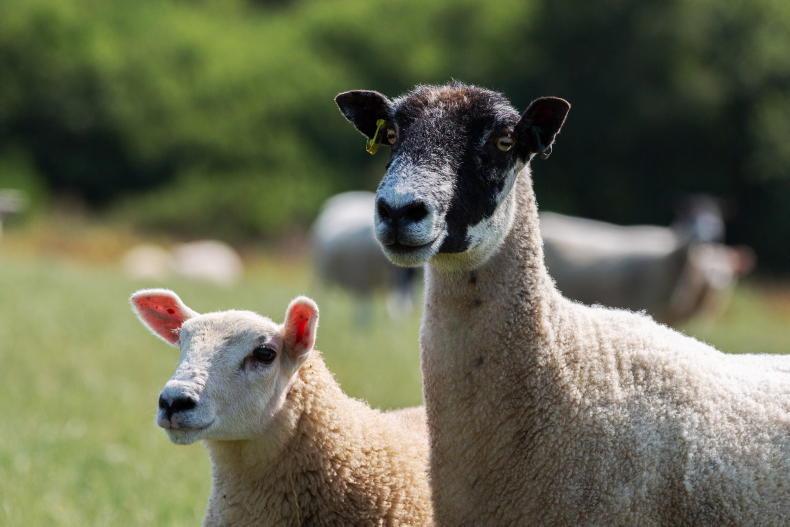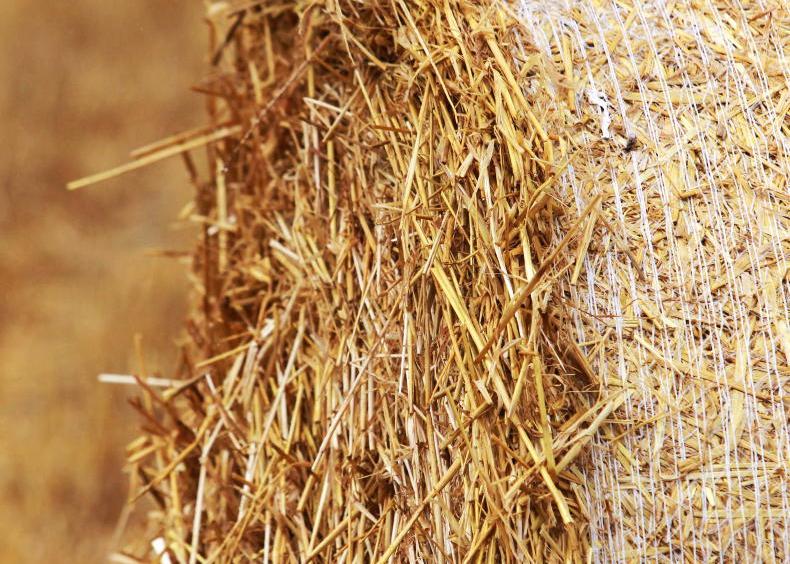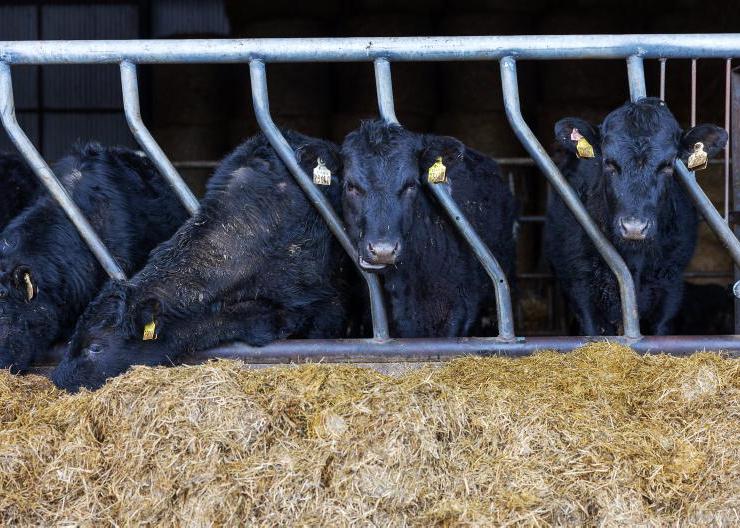The use of concentrate feeds normally increase on livestock farms during the winter housing period, increasing the cost of producing 1kg of liveweight or a litre of milk.
While ration prices have fallen from the record highs of last winter, meal is still relatively expensive when compared to previous years and current farmgate prices.
When it comes to getting the best return from purchased feed, outlined are a few things to keep in mind when choosing a ration for the upcoming winter.
1. Choose a ration based on
silage quality
On Irish farms, grass silage will form the basis of cattle diets during winter. Concentrate is meant to supplement silage, topping up energy and protein levels as necessary.
It cannot be overstressed how important a silage analysis is. The results will form the basis for any winter feed programme.
Although DMD is a good indicator of the overall feed value, pay attention to crude protein percentage. Silage can have a protein content of 13% to 15% due to a high clover percentage.
With such forages, rolled barley on its own should suffice for finishing cattle, rather than compound feed, leading to potential cost savings. In contrast, if silage was cut late, due to poor weather, protein levels may be on the low side around 10% to 11%. In such cases, a 16% to 18% ration will drive weight gain in weanlings and stores destined for sale next spring.
Such rations will initially cost more to buy, but the increased weight gain will generate a higher sale price that will cover the ration cost.
2. Pay attention to the list of ingredients
When pricing around on rations, there will be cheaper feeds that appear good value for money. However, the cheaper price may be down to the ration containing a lot of lower quality by-products.
Always ask for the list of ingredients used in the ration to allow a like-for-like comparison on the quality of ration and value for money.
The ingredients will be listed in order of inclusion rate, starting with the ingredient included at the highest rate. Look for straights like barley, maize, soya, distillers and gluten towards the start of the list.
3. Simple rations are often
better
More often than not, the simpler the ration, the better. That helps to limit the amount of filler products, which can be used to control the ration price, but often have a lower feed value.
With blended rations, check the visual quality of ingredients used. Grains that are over-processed will result in a high level of separation and dust in storage bags or bins. This leads to inconsistent feeding and an increased risk of acidosis when animals are offered high levels of meal.
4. Energy is key for finishing cattle
There is no one single ration that meets the nutritional requirements of all cattle types. Finishing cattle need energy and starch to encourage fat cover, not protein.
If protein levels are too high, finishing cattle will keep laying down lean muscle, rather than fat cover.
Keep the protein content to between 12% and 13% during the final finishing phase. Higher protein rations are likely to cost more, but will not be money well spent.
Aim for energy levels of 0.95 UFV, or 12.5 ME, and above in a finishing ration. If the energy content is not printed on the ration label, ask for it.
You are paying for the feed, so you are entitled to this information.
5. Protein is key for growing cattle and lactating cows
Stores and lactating cows have different requirements than finishing animals, so rations with higher protein levels will be needed.
For stores and weanlings, rations at 15% to 16% protein will help drive liveweight gain.
As soya-based rations tend to be more expensive, some products will use alternative proteins to keep prices competitive.
Often these alternatives are by-products from sunflower oil and oilseed rape processing, and as such, they have a high oil content, which can effect palatability and intakes.
6. Look for a good a rumen fibre source
Choose a ration with a good rumen fibre source, particularly in finishing diets. Products like soya hulls and sugar beet pulp are ideal to feed along with high cereal and starch feeds. Citrus pulp is also an alternative and good to include in calf feeds to increase palatability.
7. Is rolled barley alone an
option?
Rolled barley is a good energy source, but low in protein. Therefore, it can be a cost-saving option for finishing cattle, rather than a compound ration.
However, there are some things to remember. Firstly, barley is quickly digested in the animal’s rumen, increasing the risk of acidosis. Limit barley levels to a maximum of 3kg/head in any one feed allocation. That means, if cattle are on 6kg/day, then split barley evenly between a morning and evening feed.
Barley is also low in trace minerals, so offering mineral supplementation is recommended to ensure animal performance is not hindered.
However, rolled barley on its own is not recommended for weanling or store diets, due to low protein content. Barley should be combined with a protein balancer.
Do alternative feeds have a role in winter diets?
With high concentrates prices, there will be farmers looking at purchasing alternative feeds, such as waste vegetables, bread and other by-products from food processing.
While such products initially appear cheaper to buy, they will vary in energy, protein and dry matter content, so price alone should not be used to determine value for money.
Dried barley is taken as the standard energy feed at 1UFL. Other feeds should be priced relative to barley on a dry matter basis to allow a fair comparison.
For example, fodder beet has a high energy content at 1.12 UFL, but has a low dry matter in the region of 15% to 20%.
That means it takes around 5kg of fodder beet to supply the same amount of energy as 1kg of barley. Therefore, fodder beet should cost less than 20% of dried barley price to be value for money.
Consistency
Some by-products are easy to handle and feed out with a relatively consistent feed value. Other feeds are hugely variable in feed value, due to a high moisture content and a tendency for mould to form.
Another factor to keep in mind is availability. Cattle do not react well if their diet is constantly changing.
If using alternative feeds, make sure there is a steady supply throughout the winter to keep the diet consistent.
Give thought to native Irish rations
Most rations rely on imported straights, many of which are produced or grown using less environmentally sustainable methods than those found on Irish farms.
In recent years, several Irish feed mills have produced rations using 100% Irish grown grains and proteins. These rations are competitively priced and worth serious consideration.
As demand for 100% Irish rations increases, it will have a positive outcome for Irish tillage farms and grain prices, as well as reducing our reliance on imported products with a huge carbon footprint.
Read more
This week in photos: videos and photo slideshows from Ploughing 2023
Five tips for managing cattle at housing time
The use of concentrate feeds normally increase on livestock farms during the winter housing period, increasing the cost of producing 1kg of liveweight or a litre of milk.
While ration prices have fallen from the record highs of last winter, meal is still relatively expensive when compared to previous years and current farmgate prices.
When it comes to getting the best return from purchased feed, outlined are a few things to keep in mind when choosing a ration for the upcoming winter.
1. Choose a ration based on
silage quality
On Irish farms, grass silage will form the basis of cattle diets during winter. Concentrate is meant to supplement silage, topping up energy and protein levels as necessary.
It cannot be overstressed how important a silage analysis is. The results will form the basis for any winter feed programme.
Although DMD is a good indicator of the overall feed value, pay attention to crude protein percentage. Silage can have a protein content of 13% to 15% due to a high clover percentage.
With such forages, rolled barley on its own should suffice for finishing cattle, rather than compound feed, leading to potential cost savings. In contrast, if silage was cut late, due to poor weather, protein levels may be on the low side around 10% to 11%. In such cases, a 16% to 18% ration will drive weight gain in weanlings and stores destined for sale next spring.
Such rations will initially cost more to buy, but the increased weight gain will generate a higher sale price that will cover the ration cost.
2. Pay attention to the list of ingredients
When pricing around on rations, there will be cheaper feeds that appear good value for money. However, the cheaper price may be down to the ration containing a lot of lower quality by-products.
Always ask for the list of ingredients used in the ration to allow a like-for-like comparison on the quality of ration and value for money.
The ingredients will be listed in order of inclusion rate, starting with the ingredient included at the highest rate. Look for straights like barley, maize, soya, distillers and gluten towards the start of the list.
3. Simple rations are often
better
More often than not, the simpler the ration, the better. That helps to limit the amount of filler products, which can be used to control the ration price, but often have a lower feed value.
With blended rations, check the visual quality of ingredients used. Grains that are over-processed will result in a high level of separation and dust in storage bags or bins. This leads to inconsistent feeding and an increased risk of acidosis when animals are offered high levels of meal.
4. Energy is key for finishing cattle
There is no one single ration that meets the nutritional requirements of all cattle types. Finishing cattle need energy and starch to encourage fat cover, not protein.
If protein levels are too high, finishing cattle will keep laying down lean muscle, rather than fat cover.
Keep the protein content to between 12% and 13% during the final finishing phase. Higher protein rations are likely to cost more, but will not be money well spent.
Aim for energy levels of 0.95 UFV, or 12.5 ME, and above in a finishing ration. If the energy content is not printed on the ration label, ask for it.
You are paying for the feed, so you are entitled to this information.
5. Protein is key for growing cattle and lactating cows
Stores and lactating cows have different requirements than finishing animals, so rations with higher protein levels will be needed.
For stores and weanlings, rations at 15% to 16% protein will help drive liveweight gain.
As soya-based rations tend to be more expensive, some products will use alternative proteins to keep prices competitive.
Often these alternatives are by-products from sunflower oil and oilseed rape processing, and as such, they have a high oil content, which can effect palatability and intakes.
6. Look for a good a rumen fibre source
Choose a ration with a good rumen fibre source, particularly in finishing diets. Products like soya hulls and sugar beet pulp are ideal to feed along with high cereal and starch feeds. Citrus pulp is also an alternative and good to include in calf feeds to increase palatability.
7. Is rolled barley alone an
option?
Rolled barley is a good energy source, but low in protein. Therefore, it can be a cost-saving option for finishing cattle, rather than a compound ration.
However, there are some things to remember. Firstly, barley is quickly digested in the animal’s rumen, increasing the risk of acidosis. Limit barley levels to a maximum of 3kg/head in any one feed allocation. That means, if cattle are on 6kg/day, then split barley evenly between a morning and evening feed.
Barley is also low in trace minerals, so offering mineral supplementation is recommended to ensure animal performance is not hindered.
However, rolled barley on its own is not recommended for weanling or store diets, due to low protein content. Barley should be combined with a protein balancer.
Do alternative feeds have a role in winter diets?
With high concentrates prices, there will be farmers looking at purchasing alternative feeds, such as waste vegetables, bread and other by-products from food processing.
While such products initially appear cheaper to buy, they will vary in energy, protein and dry matter content, so price alone should not be used to determine value for money.
Dried barley is taken as the standard energy feed at 1UFL. Other feeds should be priced relative to barley on a dry matter basis to allow a fair comparison.
For example, fodder beet has a high energy content at 1.12 UFL, but has a low dry matter in the region of 15% to 20%.
That means it takes around 5kg of fodder beet to supply the same amount of energy as 1kg of barley. Therefore, fodder beet should cost less than 20% of dried barley price to be value for money.
Consistency
Some by-products are easy to handle and feed out with a relatively consistent feed value. Other feeds are hugely variable in feed value, due to a high moisture content and a tendency for mould to form.
Another factor to keep in mind is availability. Cattle do not react well if their diet is constantly changing.
If using alternative feeds, make sure there is a steady supply throughout the winter to keep the diet consistent.
Give thought to native Irish rations
Most rations rely on imported straights, many of which are produced or grown using less environmentally sustainable methods than those found on Irish farms.
In recent years, several Irish feed mills have produced rations using 100% Irish grown grains and proteins. These rations are competitively priced and worth serious consideration.
As demand for 100% Irish rations increases, it will have a positive outcome for Irish tillage farms and grain prices, as well as reducing our reliance on imported products with a huge carbon footprint.
Read more
This week in photos: videos and photo slideshows from Ploughing 2023
Five tips for managing cattle at housing time










SHARING OPTIONS